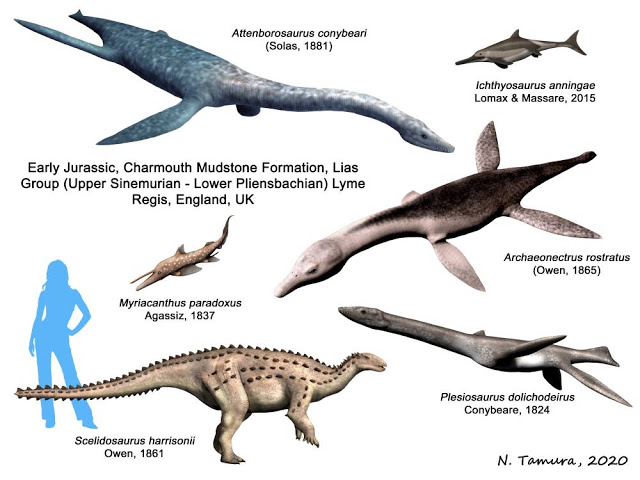|
Turnersuchus
''Turnersuchus'' is an extinct genus of thalattosuchian, a group of marine crocodylomorphs, from the Pliensbachian of the United Kingdom. It is the oldest diagnostic member of Thalattosuchia and was also found to be the group's most basal member, being situated outside the two major groups Metriorhynchoidea and Teleosauroidea. Subsequently, this genus is considered to be of great importance to understanding the relationship between thalattosuchians and other crocodylomorphs as well as their rapid diversification during the early Jurassic. ''Turnersuchus'' is a monotypic genus, meaning it includes only a single species, ''Turnersuchus hingleyae''. History and naming The fossils of ''Turnersuchus'' were discovered in 2017 within the Belemnite Marl Member of the British Charmouth Mudstone Formation in Dorset and the specimens were recorded under the West Dorset Fossil Collecting Code due to their rarity. The holotype, LYMPH 2021/45, is preserved in five large blocks with several ad ... [...More Info...] [...Related Items...] OR: [Wikipedia] [Google] [Baidu] |
Thalattosuchia
Thalattosuchia is a clade of mostly marine crocodylomorphs from the Early Jurassic to the Early Cretaceous that had a cosmopolitan distribution. They are colloquially referred to as marine crocodiles or sea crocodiles, though they are not members of Crocodilia and records from Thailand and China suggest that some members lived in freshwater. The clade contains two major subgroupings, the Teleosauroidea and Metriorhynchoidea. Teleosauroids are not greatly specialised for oceanic life, with back osteoderms similar to other crocodyliformes. Within Metriorhynchoidea, the Metriorhynchidae displayed extreme adaptions for life in the open ocean, including the transformation of limbs into flippers, the development of a tail fluke, and smooth, scaleless skin, and probably gave Viviparity, live birth, seemingly uniquely among archosaurs. Taxonomy The term Thalattosuchia was coined by Fraas in 1901.Fraas E. 1901. Die Meerkrokodile (Thalattosuchia n. g.) eine neue Sauriergruppe der Juraform ... [...More Info...] [...Related Items...] OR: [Wikipedia] [Google] [Baidu] |
Charmouth Mudstone Formation
The Charmouth Mudstone Formation is a Formation (geology), geological formation in England, dating to the Early Jurassic (Sinemurian–Pliensbachian). It forms part of the lower Lias Group. It is most prominently exposed at its type locality in cliff section between Lyme Regis and Charmouth (alongside the underlying Blue Lias) but onshore it extends northwards to Market Weighton, Yorkshire, and in the Bedrock, subsurface of the East Midlands Shelf and Wessex Basin. The formation is notable for its fossils, including those of ammonites and marine reptiles and rare dinosaur remains. The formation played a prominent role in the history of early paleontology, with its Lyme Regis-Charmouth exposure being frequented by fossil collectors including Mary Anning. Stratigraphy Shales With Beef Member The Shales With Beef Member is around 28–30 metres thick in the Lyme Regis-Charmouth region and predominantly consists of thinly bedded medium to dark grey mudstone, blocky calcareous pale ... [...More Info...] [...Related Items...] OR: [Wikipedia] [Google] [Baidu] |
Indosinosuchus Potamosiamensis
''Indosinosuchus'' is a genus of Teleosauridae, teleosaurid neosuchian that lived during the Late Jurassic or Early Cretaceous in what is now Thailand. It contains two species, the type species ''I. potamosiamensis'' and ''I. kalasinensis'', both recovered from the lower Phu Kradung Formation. It is unique among teleosauroids as it is the only named genus known from a freshwater environment, while most other members of the group are marine life, marine. ''Indosinosuchus'' is placed in the family Teleosauridae, but has a relatively robust skull that bears resemblance to members of the Machimosauridae. Biomechanical analysis of its mandible and teeth suggest that it would have had a substantial bite force comparable to animals like ''Lemmysuchus''. The two ''Indosinosuchus'' species however differ in the speed at which they could open and close their jaws, impacting their respective ecology and possibly explaining how they coexisted in the same environment. All known specimens of thi ... [...More Info...] [...Related Items...] OR: [Wikipedia] [Google] [Baidu] |


